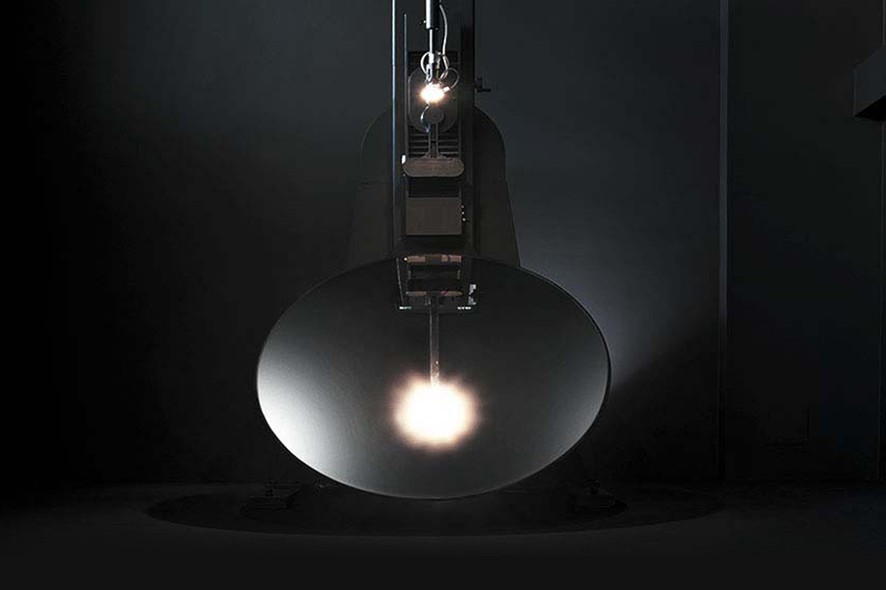Today a topic for strong palates! We tell you about the new photo-goniometer (pho-to-go-nio-me-ter) and let’s figure out together what it is and why it is so important. It’s an investment that Plexiform made recently, to equip their own technical Department with a device of the latest generation.
We read in the data sheet of the manufacturer SEDIS: “The Photoglobe 4FA photo-goniometer (P4FA) consists of an arched structure, made of aluminium, powered by an engine that rotates around the virtual axis starting from the photometric centre of light source. The illuminator is positioned towards the arch and remains fixed during the execution of the photometric measurement. A hardware interface and a powerful management software allow to capture and process measurement values, via computer, fully automatically.”
And also:
. the light source is fixed for the entire duration of the measurement and can be mounted in any operating position;
. the photometer moves on the surface of a virtual sphere whose centre coincides with the photometric centre of the light source
Fascinating isn’t it? But, you will say, what is it for? In simple terms, we can say that it serves to create the PHOTOMETRIC CURVES, which are schemes indicating in which direction and at what intensity a unit will emit light. This is because a LED itself emits a light that varies depending not only on the characteristics of the LED, but also of the device on which it is mounted (the distance from the diffuser, the material of the diffuser used, the shape of the illuminating body and many other variables).
Why use a photo-goniometer?
First to allow the Research & Development Department to design with an advanced instrument; this means designing and optimising technical and aesthetic solutions checking immediately the answers of the finished product. During elaboration and design of a new model, the integration between formal requirements and aesthetic proportions with the functionality and performance of light is fundamental. In assessing prototypes from concept to their development, the use of this equipment allows faster setup of the final solution.
Finally, the availability of a photo- goniometer within the R & D corporate Department, allows to respond quickly to new evolving market demands and industry regulations.
Why photometric curves?
Intensity and direction of light shall be measured and “certified” to meet the conditions of use of the lighting design. One of the main reference standards for the lighting world is UNI-EN12464.
We highlight here below some general check parameters:
. luminance
. luminance distribution
. uniformity
. glare (UGR)
. light direction
. colour rendering index
. colour temperature
. flickering (of LED light)
. natural light control
In connection with the final context of use of the product, that is of its location, there are specific regulations and directives; this is also why the new Plexiform catalogue is divided into 4 main areas, an extra support at the stage of selection of our products for lighting design:
. architectural
. technical
. industrial
. Health & care
Architectural
In this area we can talk about rules but also about good advice: the light near the work surface of a kitchen is of course different from the dining area or the conversation corner of a living room. With Plexiform architects and interior designers can choose from a wide range of products, flexible solutions that combine light performance to the aesthetics of the design.
Technical
The world of lighting for workplaces and offices is governed by strict rules: a user’s visual comfort in a work space, where it is often necessary to mediate natural and artificial light, is in first place. Today we are continually stimulated by light sources of digital devices (computers, tablets, mobile) and even more so it is necessary to encourage the rest of the vision and the correct use of the devices, beyond their role of furniture.
Industrial
The lighting in factories, at production sites, in departments of the industries as well as in warehouses and superstores, require products with detailed features of solidity, safety, durability and of course lighting. In some environments there are special conditions for moisture and dust, or there is a need to respond to requirements of energy saving and cost containment, for devices that comply with the need for relamping.
Healt&Care
Designers specialised in assistance, care and hospitality know that lighting is key, because it aims to improve the quality of life of a patient/guest who requires a protected environment. In this case, light can improve the perception of the paths, the identification of specific areas and act positively on the alternation of periods of activity and rest (see article about circadian rhythm) with devices that manipulate the lighting in agreement with the various times of the day and that can overcome the lack of direct contact with natural light.

 English
English Italiano
Italiano










